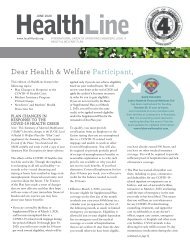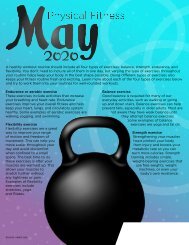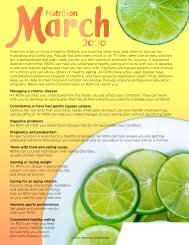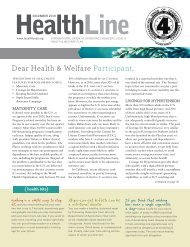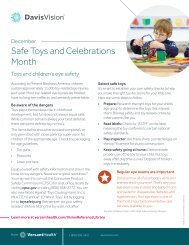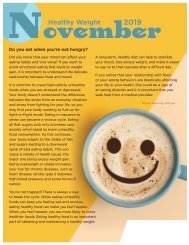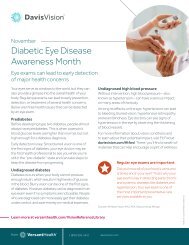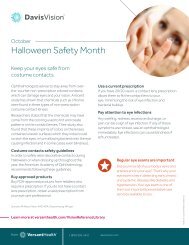June 2015
You also want an ePaper? Increase the reach of your titles
YUMPU automatically turns print PDFs into web optimized ePapers that Google loves.
HealthLine<br />
<strong>June</strong> <strong>2015</strong><br />
www.local4funds.org<br />
International union of Operating Engineers local 4<br />
health & Welfare plan<br />
Dear Health & Welfare Participant,<br />
This edition of HealthLine features the<br />
following topics:<br />
• Enhanced Benefits: Nutritional<br />
Counseling and Speech Therapy<br />
• What You Should Know Before You<br />
Receive Care: Usual and Customary<br />
Charges<br />
• Newborns’ and Mothers’ Health<br />
Protection Act<br />
• Revised Eligibility Requirement for<br />
New Members of Local 4D<br />
• Social Security Numbers for All<br />
Covered Members and Dependents<br />
• Subscriber Claims<br />
ENHANCED BENEFITS:<br />
NUTRITIONAL COUNSELING<br />
AND SPEECH THERAPY<br />
The Board of Trustees is pleased to<br />
announce, effective January 1, <strong>2015</strong>,<br />
nutritional counseling will be a covered<br />
benefit in the event of illness or injury. In<br />
addition, speech therapy will be a covered<br />
benefit when prescribed by a physician.<br />
To find out more about these benefits,<br />
call Blue Cross and Blue Shield (BCBS) at<br />
1-800-401-7690.<br />
WHAT YOU SHOULD KNOW<br />
BEFORE YOU RECEIVE CARE:<br />
USUAL AND CUSTOMARY<br />
CHARGES<br />
For out-of-network providers who do<br />
not have a PPO payment agreement with<br />
BCBS, BCBS will cover the provider’s<br />
charge up to the “usual and customary”<br />
charge. This charge is established by BCBS<br />
as appropriate based on its fee schedule<br />
with in-network providers. The usual and<br />
customary charge may be less than the<br />
out-of-network provider’s actual charge.<br />
If that is the case, you will be responsible<br />
for the difference between the usual and<br />
customary charge that BCBS pays and the<br />
provider’s actual charge (in addition to your<br />
deductible and/or copayment and/or coinsurance,<br />
as applicable). Remember, usual<br />
(health bits)<br />
You can host a birthday party<br />
for children that’s nutritious<br />
with these healthy ideas suggested by the<br />
Academy of Nutrition and Dietetics: Instead<br />
of serving soda or another sweetened drink,<br />
opt for fruit juice mixed with sparkling water<br />
for a liquid refresher with less sugar. Serve<br />
mini meatball dippers for a protein-packed<br />
finger food. Whip up a simple trail mix made<br />
with whole-grain cereal, nuts, and dried fruit.<br />
and customary charges will not apply if you<br />
visit an in-network provider.<br />
NEWBORNS’ AND MOTHERS’<br />
HEALTH PROTECTION ACT<br />
This act requires group health care plans<br />
to provide a minimum hospital stay for<br />
the mother and newborn child of 48 hours<br />
after a vaginal delivery and 96 hours after<br />
a cesarean section. However, federal law<br />
does not prohibit the mother’s or newborn’s<br />
attending physician—in consultation<br />
with the mother—from determining that<br />
a shorter length of stay is appropriate. The<br />
Plan requires admission certification of<br />
your maternity stay only if the minimum<br />
length of stay (48 or 96 hours, as applicable)<br />
is exceeded. A stay exceeding the minimum<br />
length requires authorization and is<br />
subject to review for medical appropriateness.<br />
Under the Plan, a pregnancy-related<br />
hospital stay is treated like an illness, as<br />
required by federal law.<br />
(continued on page 8)<br />
Indoor or outdoor cycling is<br />
a good sport for people with<br />
arthritis because it works all the<br />
muscles in the lower body, even the<br />
feet. But when you ride outside, the<br />
Arthritis Foundation recommends<br />
you wear padded cycling gloves that<br />
absorb shock. Also, avoid using a bike<br />
with handlebars that cause you to<br />
hunch over, which puts added stress<br />
on your hands, wrists, and elbows.
2<br />
5<br />
Ways to Eat Healthy<br />
This Summer<br />
ICE CREAM, HOT DOGS, FRIED DOUGH<br />
AT THE FAIR—summer doesn’t always have<br />
the best rep, nutrition-wise. With a few<br />
simple tweaks, you can avoid extra pounds,<br />
food poisoning, and other dietary disasters<br />
during these lazy, hazy days. Here’s how:<br />
1<br />
Stay trim while you<br />
travel.<br />
Carrying healthy, quick meals and<br />
snacks keeps you from braking<br />
for fast food on summer journeys. Pack<br />
unsalted nuts, peanut butter sandwiches on<br />
whole-grain bread, fruit such as bananas<br />
and apples, and tuna snack packs. Extralong<br />
drive? Stock a cooler with hummus,<br />
light yogurt, berries, salad greens, hardboiled<br />
eggs, and whole-grain veggie or<br />
turkey sandwiches.<br />
2Try good-for-you<br />
grilling.<br />
Move over, cheeseburgers—transform<br />
your barbecue into a health<br />
food haven. Choose fish like salmon, trout,<br />
and herring for heart-healthy omega-3 fatty<br />
acids. Serve salads or grilled veggies on the<br />
side. And try searing fruit such as peaches<br />
or pineapple slices over the flames for a<br />
naturally sweet dessert.<br />
(test your savvy on … the Mediterranean diet)<br />
3Take caution with<br />
contamination.<br />
Don’t let a stomach bug spoil your<br />
good times. Fight foodborne illness<br />
by washing your hands frequently. Rinse all<br />
fresh fruits and veggies carefully. Keep raw<br />
and cooked foods separate and use a food<br />
thermometer to check that grilled foods<br />
are done (between 145 and 165 degrees,<br />
depending on the cut). And don’t let picnic<br />
dishes linger—refrigerate or toss perishables<br />
after an hour in the summer heat.<br />
4Pick up seasonal<br />
superfoods.<br />
Summer harvests and markets<br />
abound with nutritious produce.<br />
Healthy, farm-fresh options include summer<br />
squash, such as zucchini or pattypan,<br />
and fruits, such as watermelon and berries.<br />
5Make these smart<br />
restaurant swaps.<br />
Eating out? Even beachside bistros<br />
now offer more nutritious options.<br />
Order veggie dogs instead of hot dogs,<br />
grilled corn on the cob over french fries,<br />
grilled chicken instead of greasy burgers,<br />
and low-fat fruit smoothies or popsicles<br />
instead of ice cream. To stay hydrated without<br />
the sugar of soda, wash your meal down<br />
with sparkling water spritzed with lemon<br />
or mint.<br />
1. The Mediterranean diet consists of red meat, dairy products, and<br />
lots of bread.<br />
True False<br />
2. This diet contains less saturated fat than the typical American diet.<br />
True False<br />
3. Following the Mediterranean diet seems to improve several of the<br />
factors of metabolic syndrome, including high blood pressure,<br />
elevated blood sugar, obesity, and unhealthy cholesterol.<br />
True False<br />
4. One study found that pregnant women who ate a Mediterranean<br />
diet produced children who were less likely to have allergies and<br />
wheezing.<br />
True False<br />
ANSWERS<br />
1. False. People following this diet eat plenty of fruits and<br />
veggies, whole grains, nuts, and fish.<br />
2. True. The amount of saturated fat also falls within the<br />
American Heart Association’s dietary recommendations.<br />
3. True. The diet can also lower your risk for heart disease<br />
and stroke, and it may help prevent and manage<br />
diabetes. Other studies show that the Mediterranean diet<br />
could ward off Alzheimer’s disease and some cancers.<br />
4. True. The high levels of disease-fighting compounds in<br />
the Mediterranean diet foods helped protect these children<br />
against allergies and wheezing.
3<br />
What’s Your Sun<br />
Safety IQ?<br />
www.cancer.org, then search for<br />
“summer safety quiz”<br />
When you exercise outside<br />
during the summer months,<br />
it’s important to keep yourself<br />
protected from the sun’s damaging<br />
ultraviolet rays. Unsure of<br />
how to keep your skin safe? Test<br />
your knowledge with this ninequestion<br />
quiz from the American<br />
Cancer Society. Every question<br />
will provide you with details<br />
about sun cancer risk, when and<br />
where to apply sunscreen, how<br />
often to reapply it, and more.<br />
For Better Health,<br />
Prescribe Yourself Some Exercise<br />
WANT A PRESCRIPTION FOR BETTER<br />
HEALTH? GET A MOVE ON. As you may<br />
know, regular physical activity can reduce<br />
your risk for heart disease, type 2 diabetes,<br />
and bone-weakening osteoporosis.<br />
But the list doesn’t end there. Here are<br />
other powerful ways exercise is proving<br />
to be the best medicine.<br />
Cancer Prevention<br />
Physical activity in any form may lower<br />
cancer risk, according to the American<br />
Institute for Cancer Research (AICR).<br />
It helps you maintain a healthy weight,<br />
which can reduce your risk for cancer.<br />
But exercise may also strengthen your<br />
immune system, help keep your digestive<br />
system healthy, and allow you to consume<br />
more food with cancer-protective<br />
nutrients without gaining weight. Fruits,<br />
vegetables, and beans, for example, contain<br />
fiber and phytochemicals, which may<br />
help prevent cancer-causing cell damage.<br />
A Healthier Nervous System<br />
Running may help prevent Parkinson’s<br />
disease, a neurological disease that’s<br />
caused by the death of neurons that produce<br />
dopamine, a chemical in the brain<br />
that controls movement. A study in Brain,<br />
Behavior, and Immunity found that running<br />
may protect against inflammation that<br />
can lead to the death of these neurons.<br />
A Longer Life<br />
Exercise helps you live healthier for<br />
longer. In fact, people who are physically<br />
active for about seven hours a week have<br />
a 40 percent lower risk of dying early<br />
compared to those who are active for less<br />
than 30 minutes each week, according<br />
to the Centers for Disease Control and<br />
Prevention.<br />
Exercise Rx<br />
For better health, try to log in 150<br />
minutes each week of moderately intense<br />
activity, such as brisk walking, or 75<br />
minutes per week of vigorous exercise,<br />
such as jogging or running, and at least<br />
two weekly sessions of strength training.<br />
For greater disease protection, however,<br />
feel free to do even more. For cancer prevention,<br />
the AICR recommends aiming<br />
for 60 minutes or more of daily moderate<br />
activity, such as brisk walking, or 30<br />
minutes or more of vigorous activity.<br />
Similarly, to prevent Parkinson’s disease,<br />
a recent study in Brain found that getting<br />
more than six hours per week of physical<br />
activity reduced the risk of contracting<br />
the neurological disorder by 43 percent.<br />
Need a push?<br />
For exercise email tips, sign up at www.exerciseyourlife.org.
4<br />
Expecting Parents:<br />
Should You Get a Keepsake Ultrasound?<br />
HER FIRST PAIR OF SHOES. HIS<br />
FAVORITE STUFFED ANIMAL. Most<br />
parents keep mementos from their baby’s<br />
early days—and government officials<br />
usually don’t have much to say about it.<br />
However, the U.S. Food and Drug<br />
Administration (FDA) has issued a warning<br />
on one keepsake: nonmedical ultrasounds.<br />
Doctors safely use these imaging<br />
tests during prenatal visits. But the FDA<br />
advises families to steer clear of retail<br />
outlets offering photos and even videos of<br />
their impending arrivals.<br />
A Valuable Medical Tool<br />
When you go for an ultrasound, a doctor<br />
or technician rubs a thin layer of gel<br />
on your stomach. He or she then uses<br />
a device called a transducer to transmit<br />
sound waves through your insides.<br />
As the sound waves bounce off your<br />
uterus and baby, they form a black-andwhite<br />
image you and your doctor can<br />
see. Three- or four-dimensional versions<br />
provide added detail and even motion.<br />
Unlike X-rays, ultrasounds use no<br />
ionizing radiation. That’s one reason<br />
they’re used during pregnancy. Routine<br />
ultrasounds can help your doctor check<br />
that your baby is developing properly. As<br />
a side perk, they help you bond with your<br />
baby and capture images you can share<br />
with family and friends.<br />
Safe—But Use Sparingly<br />
Ultrasounds have few risks. No evidence<br />
links them to any health problems for<br />
mothers or babies. But they do slightly<br />
heat some tissues.<br />
FDA experts say the long-term effects<br />
of these processes aren’t known. So, it’s<br />
best to get ultrasounds only when medically<br />
necessary. Your doctor can tell you<br />
how often he or she recommends the test.<br />
What’s more, keepsake ultrasounds are<br />
offered outside a medical office. There’s<br />
no guarantee the machines are used<br />
safely. The staff may not have received<br />
proper training in operating the equipment<br />
and might not know what to do<br />
if they detect a complication with your<br />
baby. Plus, some videos require exposure<br />
to ultrasound waves for up to an hour.<br />
That’s far longer than the procedure<br />
takes in a medical facility—usually about<br />
20 minutes.
5<br />
Making the Choice:<br />
Family Medicine Practitioner or Internal Medicine Physician?<br />
Q& A<br />
WHEN YOU’RE ILL, you have a<br />
choice of what kind of doctor<br />
to see. And unless you need a specialist,<br />
such as for a heart condition, your choice<br />
will typically be between a family medicine<br />
doctor or an internist.<br />
Learn more about the differences and<br />
similarities between these two providers<br />
to help you make informed choices for<br />
your health care needs.<br />
QWho do family medicine<br />
doctors treat?<br />
Family medicine specialists<br />
focus on health care for men and women<br />
of every age—from newborns to seniors.<br />
Because of this, they are the only medical<br />
specialists trained to treat most medical<br />
conditions.<br />
During their residencies, family medicine<br />
specialists are trained in pediatrics,<br />
obstetrics and gynecology, emergency<br />
medicine, ophthalmology, radiology,<br />
orthopedics, otolaryngology (ear, nose,<br />
and throat conditions), and urology.<br />
Family physicians diagnose, treat,<br />
and manage most chronic illnesses in<br />
addition to providing preventive health<br />
care, including checkups, immunizations,<br />
screening tests, and counseling on how to<br />
maintain a healthy lifestyle.<br />
QWhat is the focus of<br />
internal medicine<br />
physicians?<br />
Internists, or internal medicine physicians,<br />
provide health care for adults only.<br />
They are trained extensively in a variety<br />
of subspecialities, such as in acute and<br />
chronic care, mental health care (including<br />
substance abuse), malfunction of<br />
the nervous system and reproductive<br />
organs, and general women’s health care<br />
and gynecology, but not maternity care.<br />
Internal medicine physicians can also<br />
address disease prevention with patients.<br />
QWhen should you<br />
choose one over the<br />
other?<br />
The kind of doctor you choose depends<br />
on your gender and age. For example, if<br />
you are a woman of childbearing age, you<br />
can get ongoing care from a family doctor<br />
before, during, and after a pregnancy.<br />
Likewise, if you have children, you<br />
can receive care for yourself and your kids<br />
from a family doctor but not an internist.<br />
Your decision may also be influenced<br />
by your heath care plan. For example,<br />
your health insurance company’s in-network<br />
doctors may include a family doctor<br />
you are interested in, but not the internist<br />
you’d like to see or vice versa.<br />
(health bits)<br />
Don’t be afraid to<br />
approach a boss who’s<br />
sitting alone at lunch or<br />
a social occasion, advises<br />
Richard Templar in The Rules of<br />
Work. Go up and make small talk,<br />
but just don’t ask about a pay raise<br />
or time off for vacation. Bosses<br />
usually appreciate workers talking<br />
with them because they can feel<br />
isolated and ignored.<br />
With strength training,<br />
lifting lighter weights for<br />
more repetitions doesn’t<br />
usually lead to significant<br />
strength gains, notes<br />
the American Council on<br />
Exercise. To increase muscle<br />
size and your strength, it’s<br />
more effective to turn up the<br />
intensity. That means it’s<br />
better to work your muscles<br />
harder by lifting heavier<br />
weights for fewer reps.<br />
YOUR FOOT TYPE<br />
dictates the best shoe<br />
option for your athletic<br />
endeavors. If you have high-arched feet,<br />
the American Council on Exercise advises that you<br />
buy shoes with greater shock absorption. You’re<br />
also susceptible to ankle injuries because you could<br />
have poor lateral stability, so you need shoes that<br />
provide good ankle support. If you have low-arched<br />
(flat) feet, look for shoes with less cushioning but<br />
greater support in the mid-foot region and heel.
6<br />
Binge Drinking<br />
Can Boost Blood Pressure in Young Men<br />
YOU MIGHT HAVE AN ALCOHOLIC<br />
BEVERAGE ON CERTAIN OCCASIONS,<br />
such as enjoying a beer at a ball game or<br />
raising a toast in celebration. Drinking<br />
in moderation is not a problem for most<br />
individuals.<br />
But drinking way too much at one<br />
time, known as binge drinking, can have<br />
serious consequences, including alcohol<br />
poisoning, heart and liver disease, brain<br />
damage and sexual dysfunction, and<br />
more.<br />
Additionally, a recent study of about<br />
8,600 young men and women found<br />
that men who binge drank in early adulthood<br />
increased their risk of developing<br />
high blood pressure.<br />
How Much Is Too Much?<br />
Binge drinking is as a drinking pattern<br />
that brings a person’s blood alcohol concentration<br />
to 0.08 percent or higher. Men<br />
are likely to reach this level when they<br />
have five or more drinks in two hours,<br />
and women when they have four or more<br />
in the same time frame.<br />
A standard drink contains<br />
about 14 g (0.6 fluid oz.) of<br />
pure alcohol. A standard drink<br />
is equivalent to 12 fluid oz. of<br />
beer, 8 to 9 fluid oz. of malt<br />
liquor, 5 fluid oz. of wine, or<br />
1.5 fluid oz. of hard liquor.<br />
Control Binge Drinking<br />
These strategies can help you<br />
reduce binge drinking. If you are<br />
unable to cut back on your own,<br />
seek assistance from your doctor or<br />
a substance abuse professional.<br />
• Decide ahead of time how much<br />
you will drink during a night out.<br />
• Track how much you drink by recording<br />
your intake on your smartphone,<br />
or by writing it down in a<br />
notebook. Keeping tabs<br />
A Standard<br />
Drink<br />
12 oz. Beer<br />
8-9 oz. Malt Liquor<br />
5 oz. Wine<br />
1.5 oz. Hard Alcohol<br />
on your drinking can<br />
help you stick to a limit.<br />
• Pace your drinks by<br />
having sparkling water<br />
or juice in between each<br />
alcoholic beverage.<br />
• Avoid places that, or<br />
people who, are likely<br />
to trigger your desire to<br />
excessively drink.<br />
• Ask friends and family<br />
to support your efforts to<br />
cut back.<br />
• Join a support group, such<br />
as Alcoholics Anonymous.<br />
See for yourself<br />
Visit www.rethinkingdrinking.niaaa.nih.gov to assess your drinking<br />
pattern. Search for “what’s your pattern?”<br />
To add more<br />
whole grains<br />
to your diet, start<br />
partnering them with<br />
your meals, suggests the<br />
Academy of Nutrition and Dietetics. For<br />
example, complement a vegetable<br />
stir-fry with brown rice or eat<br />
a whole wheat pita stuffed<br />
with salad. You can also add<br />
high-fiber ingredients to<br />
mixed dishes. For example,<br />
put bran or oatmeal in your<br />
meat loaf.<br />
(health bits)<br />
Half of all people with<br />
high blood pressure take<br />
at least two medications<br />
to control the condition,<br />
according to the U.S. Food<br />
and Drug Administration. The<br />
medications begin to work within<br />
days. But once you start using<br />
them, you shouldn’t stop taking<br />
them until your doctor says so.<br />
Over time, not treating high<br />
blood pressure can cause kidney<br />
failure, stroke, blindness, and<br />
heart attack.<br />
When you’re dealing with<br />
a difficult situation, the<br />
American Psychological Association<br />
recommends you avoid seeing it as<br />
something impossible to overcome.<br />
Try to look ahead and acknowledge<br />
how the present circumstances<br />
could get better. Also, start noticing<br />
the subtle ways in which you’re<br />
already doing better as you continue<br />
dealing with the situation.
(recipe)<br />
7<br />
Pick the Right Foods from<br />
South of the Border<br />
YOU MAY CRAVE MEXICAN FOOD, but those chips, queso dip, and many other items<br />
on Mexican restaurant menus add a lot of fat and calories to your diet. And that’s no<br />
bueno. Fortunately, smart choices allow you to get your Mexican food fix without<br />
sacrificing healthy dining habits.<br />
Decode the Menu<br />
Most Mexican restaurants have choices that will keep your meal healthy and low in fat.<br />
Try these suggestions:<br />
• Order fresh seafood or lean poultry. Items such as chicken or shrimp fajitas or fish<br />
tacos are preferable to beef tacos or cheese enchiladas.<br />
• Request for sauces and toppings to come on the side or substitute salsa for sour<br />
cream, cheese sauce, and guacamole. While avocados contain healthy fats, guacamole<br />
is higher in fat than salsa.<br />
• Ask for your taco salad on the plate instead of in a fried taco shell.<br />
• Choose soft versus fried (hard shell) tortillas for tacos, and corn instead of flour<br />
tortillas for enchiladas and quesadillas. Corn tortillas are fat free and provide more<br />
nutrients.<br />
• Ask for a small portion of Mexican rice.<br />
• Go for black or pinto beans rather than refried beans made with lard or other fat.<br />
• Key menu words to help you order lighter are asada (grilled) and Veracruz-style<br />
(with tomato sauce). Choose items that are broiled, baked, or grilled vs. fried.<br />
• Steer clear of food with cheese, which is high in fat and sodium.<br />
• If you want to have a drink, opt for a light Mexican beer over a margarita, which is<br />
higher in calories and carbohydrates. The salt on the side of the glass doesn’t help, either.<br />
One more table tip: Get those complimentary fried tortilla chips off the table.<br />
Ask the server to take them away to avoid temptation.<br />
Substitute salsa for sour cream, cheese sauce, and guacamole.<br />
Table tip: Order fresh seafood or lean poultry.<br />
Mexican Pozole<br />
No need to<br />
travel—get your<br />
Mexican food fix<br />
right at home!<br />
2 lb. lean beef (eye round roast),<br />
cubed<br />
1 tbsp. olive oil<br />
1 large onion, chopped<br />
1 clove garlic, finely chopped<br />
¼ tsp. salt<br />
¹⁄8 tsp. ground black pepper<br />
¼ cup cilantro<br />
1 can (15 oz.) stewed tomatoes<br />
¹⁄ ³ can (2 oz.) no salt added tomato<br />
paste<br />
1 can (1 lb., 13 oz.) hominy<br />
Heat olive oil in a large pot. Gently<br />
blot beef cubes dry with paper<br />
towels, carefully place them in the<br />
pot, and sauté. Mix in onion, garlic,<br />
salt, pepper, cilantro, and enough<br />
water to cover the meat.<br />
Cover pot and cook over low heat<br />
until meat is tender. Add tomatoes<br />
and tomato paste. Continue cooking<br />
for about 20 minutes. Add hominy<br />
and continue cooking for another 15<br />
minutes, stirring occasionally, over<br />
low heat. If too thick, add water for<br />
desired consistency.<br />
Tip: As a variation, boneless,<br />
skinless chicken breasts may be<br />
used instead of beef cubes.<br />
Serves 10. Each serving contains<br />
about 253 calories, 10 g total fat, 3 g<br />
saturated fat, 52 mg cholesterol, 425<br />
mg sodium, 19 g carbohydrates, 4 g<br />
fiber, and 22 g protein.<br />
Source: National Heart, Lung, and Blood Institute/National<br />
Institutes of Health
IUOE Local 4 Health & Welfare Plan<br />
PO Box 660<br />
Medway, MA 02053-0660<br />
PRSRT Std<br />
U.S. Postage<br />
Paid<br />
Long Prairie, MN<br />
Permit No. 372<br />
www.local4funds.org<br />
(health bits)<br />
When you’re writing a<br />
report, Bryan A. Garner stresses<br />
in the HBR Guide to Better Business<br />
Writing that you must do enough research<br />
to grasp the problem and then<br />
state it so people who see the report<br />
understand why the issue needs<br />
resolving. If you’re making a recommendation,<br />
Garner says you need to<br />
remember the five w’s and an h: You<br />
should spell out what needs to done,<br />
identify who should do it, and specify<br />
when, where, why, and how it should<br />
be done.<br />
If you suspect you have<br />
a gallbladder problem,<br />
the National Institutes of Health<br />
recommends you talk with your<br />
doctor. The symptoms include<br />
sudden, severe pain in the upper<br />
right side of your abdomen that<br />
lasts between 30 minutes to several<br />
hours; pain under your right shoulder<br />
or in your right shoulder blade; and<br />
indigestion after eating foods high in<br />
fat or protein, including desserts and<br />
fried foods.<br />
Learn to put positive spins<br />
on any negatives, stresses<br />
Lois P. Frankel, Ph.D., in Nice Girls<br />
Still Don’t Get the Corner Office. For<br />
example, don’t say you could’ve<br />
done a better job of keeping your<br />
department under budget. A better<br />
way to express the message is<br />
“Although we didn’t come in under<br />
budget, we did complete the project<br />
ahead of schedule.”<br />
(continued from page 1)<br />
REVISED ELIGIBILITY<br />
REQUIREMENT FOR<br />
NEW MEMBERS OF<br />
LOCAL 4D<br />
If you are a participant in<br />
Local 4D covered by an<br />
Equipment House Contract,<br />
in the calendar year in which<br />
you receive your first credited<br />
hour, you will become<br />
eligible for coverage under<br />
the Basic Eligibility Rule for<br />
the 12-month period beginning<br />
the following March 1,<br />
if you have worked 1,000<br />
or more credited hours and<br />
remain employed working<br />
under an Equipment House<br />
Contract as of December 31<br />
of that same year. This Plan<br />
amendment is retroactive<br />
to January 1, 2014. In other<br />
words, if you are in Local 4D,<br />
received your first credited<br />
hour in 2014, worked<br />
through December 31, 2014<br />
under an Equipment House<br />
Contract, and worked in<br />
excess of 1,000 hours in 2014,<br />
you will be covered under<br />
the Basic Plan commencing<br />
March 1, <strong>2015</strong>. However, in<br />
all calendar years after you<br />
receive your first credited<br />
hour as a participant in<br />
Local 4D, you will need to<br />
work 1,500 or more hours to<br />
remain eligible for coverage<br />
under the Basic Plan.<br />
SOCIAL SECURITY<br />
NUMBERS REQUIRED<br />
FOR ALL MEMBERS<br />
AND DEPENDENTS<br />
Members must submit their<br />
Social Security number as<br />
well as the Social Security<br />
numbers of all dependents<br />
who will be covered under<br />
the Plan, as required by federal<br />
law. The Benefit Funds<br />
Office will be sending out a<br />
mailing in the near future to<br />
gather any numbers not currently<br />
on file.<br />
SUBSCRIBER CLAIMS<br />
All Department of Transportation<br />
(DOT) physical<br />
exams, massage therapy,<br />
acupuncture, acupressure,<br />
and homeopathic medicine<br />
claims must be submitted by<br />
the subscriber (the member)<br />
to BCBS. A reimbursement<br />
form is available on<br />
the Benefit Funds website,<br />
www.local4funds.org,<br />
under the Participant Forms<br />
tab. Your BCBS identification<br />
number must be printed<br />
on the form, and an itemized<br />
statement and receipt of payment<br />
must accompany the<br />
form. Any forms submitted<br />
to the Benefit Funds Office<br />
will be mailed back to the<br />
member for proper submission<br />
to BCBS.<br />
Sincerely,<br />
Your Board of Trustees<br />
Louis G. Rasetta, Chairman<br />
Nino Catalano<br />
Paul C. DiMinico<br />
David F. Fantini<br />
James Reger<br />
John J. Shaughnessy, Jr.<br />
IUOE Local 4<br />
Louis G. Rasetta,<br />
Business Manager<br />
Administrator<br />
Gina M. Alongi<br />
Information in the publication is the opinion of the authors. Personal decisions regarding health, finance, exercise, and other matters should be made<br />
after consultation with the reader’s professional advisors. All models used for illustrative purposes only. All editorial rights reserved. (6272M)




